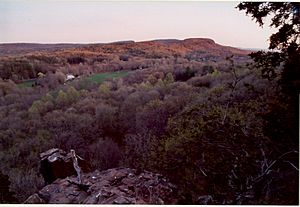Short Mountain (Connecticut) facts for kids
Quick facts for kids Short Mountain |
|
|---|---|

View from Short Mountain; Hanging Hills in distance
|
|
| Highest point | |
| Elevation | 530 ft (160 m) |
| Parent peak | 41° 36' 09"N, 72° 49' 27"W |
| Geography | |
| Location | Southington and Berlin, Connecticut |
| Parent range | Metacomet Ridge |
| Geology | |
| Age of rock | 200 Ma |
| Mountain type | fault-block; igneous |
| Climbing | |
| Easiest route | Metacomet Trail |
Short Mountain is a cool mountain in central Connecticut. It's about 5 miles (8 km) north of Meriden. This mountain is part of the Metacomet Ridge. This long, narrow ridge stretches from Long Island Sound all the way up to the Vermont border.
Short Mountain is famous for its amazing cliffs. It also has special natural areas called microclimates. These areas support rare plants and animals. You can hike on the 51-mile (82 km) Metacomet Trail that goes right over the mountain.
Contents
Where is Short Mountain?
Short Mountain is located in two towns: Southington and Berlin, Connecticut. It rises sharply about 200 feet (61 m) above the valleys nearby. To the west is the Quinnipiac River valley. To the east is the Mattabesett River valley.
The highest point of Short Mountain is 530 feet (162 m) above sea level. The mountain is about 1 mile (1.6 km) long and 0.5 miles (0.8 km) wide. Even though it seems small, its steep slopes make it feel much larger. The Metacomet Ridge continues south from Short Mountain as the Hanging Hills. To the north, it becomes Ragged Mountain.
How Short Mountain Formed
Short Mountain is made of a type of rock called basalt. Basalt is also known as traprock. This rock comes from volcanic activity. The mountain formed about 200 million years ago. This was near the end of the Triassic Period.
At that time, the continents of North America, Africa, and Eurasia were pulling apart. Hot, melted rock (lava) came up from deep inside the Earth. This lava spread out and cooled, forming thick layers of solid rock. Later, big cracks in the Earth (called faults) and earthquakes caused these rock layers to tilt. This tilting created the steep cliffs and the long ridge of Short Mountain that we see today.
Unique Nature on the Mountain
Short Mountain has many different types of environments. The upper slopes are often hot and dry. The ravines (small valleys) are cool and moist. There are also rocky ledges made of basalt talus (broken rock pieces).
These different conditions create special microclimate ecosystems. A microclimate is like a tiny weather zone. These unique zones help many plant and animal species to live here. Some of these species are rare in other parts of Connecticut. Short Mountain is also an important path for raptors (birds like hawks and eagles) when they migrate.
Hiking and Protecting the Mountain
The Metacomet Trail is 51 miles (82 km) long. It goes right over Short Mountain. The Connecticut Forest and Park Association helps take care of this trail. People use the trail for hiking and snowshoeing. There are several spots along the trail with amazing views. You can see the countryside below and the Hanging Hills to the north.
Most of the top of Short Mountain is protected land. This means it's set aside for nature. In 2000, Short Mountain was part of a study by the National Park Service. They were looking at creating a new long-distance trail. This trail is now called the New England National Scenic Trail. It would connect the Metacomet-Monadnock Trail in Massachusetts with the Mattabesett Trail and Metacomet Trail in Connecticut.
The Berlin Land Trust also works to protect this part of the Metacomet Ridge.

